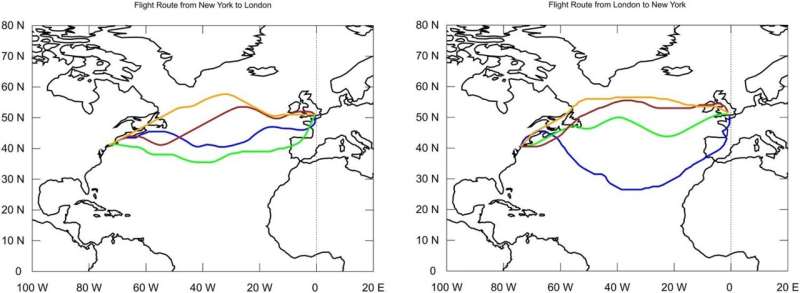
Flying is the most damaging mode of transportation for our climate. At least, up until now. But work is already underway to investigate technical alternatives to conventional aircraft.
For example, airships with highly efficient solar cells and extremely light batteries on board. Prof. Dr. Christoph Pflaum from FAU, together with Prof. Dr. Agnes Jocher from the Technical University of Munich (TUM) and the FAU student Tim Riffelmacher, has investigated which route a solar airship would have to take in order to fly from London to New York as quickly and as climate-friendly as possible.
The findings were published in the International Journal of Sustainable Energy.
"If we rely on solar-powered airships, we can make aviation more climate-friendly relatively quickly and economically," says Prof. Dr. Christoph Pflaum. The computer science professor at FAU specializes in numerical simulation with high-performance computers and has published the paper "Design and route optimization for an airship with onboard solar energy harvesting," together with FAU student Tim Riffelmacher and Professor Jocher from TUM.
Climate-friendly and cost-effective air travel
"Our calculations show that solar airships could significantly reduce both transport costs and the CO2 emissions of air travel," explains Professor Pflaum. In the course of his research, the scientist has become a true fan of solar-powered air travel and eagerly lists its many benefits: "Solar airships are absolutely climate-friendly because they are equipped with extremely light and highly efficient thin-film solar cells that recharge over again during the flight. As a result, no combustion-related emissions are generated while the airship is flying."
Energy from the power grid is only needed to recharge the battery before the airship is launched and the charging process has very low CO2 emissions. "A maximum of five percent of the amount of carbon dioxide generated in conventional air transport is emitted," he says and refers to the figures: Compared with long-haul freight flights, less than one percent is generated, by medium-haul flights almost 1.4 percent and for person transport approximately five percent.
"Unfortunately, this solar airship does not exist at the moment, but in California a company is investing heavily in developing a large, fully rigid airship for the first time in 90 years, which offers a lot of space and is well protected in wind and weather," says Professor Pflaum.
The technology can be implemented quickly, but has been quite neglected in recent decades. "Of course, the tragedy of the airship LZ 129, better known as 'Hindenburg' has influenced this lack of progress," the professor acknowledges. "With a length of 245 meters and a diameter of 41.2 meters, LZ 129 was one of the largest aircraft ever built and a real sensation on its maiden voyage in March 1936. But just a year later, it caught fire when it landed in the U.S. and was completely destroyed." This meant the end of airships for a long time, but now they are being rethought with solar cells on board and work is underway on a "real game changer."
With these new models, no one needs to be afraid of a fire, as the airships are neither filled with combustible hydrogen nor with any other fuel.
The researchers believe that cost aspects also speak in favor of solar airships, because the energy consumption costs of solar-powered airships are, according to their current calculations, significantly lower than those of conventional aircraft.
Two to three days for a flight across the Atlantic
Are solar airships a real technical alternative to conventional aircraft? "It looks promising," Professor Pflaum and Professor Jocher agree. "We only have to lower our expectations for flight time, because an airship flies much slower than an airplane."
Several FAU students simulated and calculated in their Bachelor's and Master's theses how fast an airship with solar cells on board would really be and which route it would have to take in order to optimally exploit wind and weather and sun positions. Most recently, Tim Riffelmacher dealt with the "Charging optimization of the battery in a solar airship with simulated annealing" in his Bachelor's thesis.
He, too, is very enthusiastic about the solar-powered airships and took a closer look at battery use during day and night in his simulations. "The battery is charged before the flight and then has to last for long distances," explains the young researcher. "This is easier said than done, because at night there is no sun and the solar cells do not produce electricity." But optimizing the charging process makes a lot of things possible.
In their work, Riffelmacher and the other students were able to show that national, continental and even intercontinental flights with a satisfactory flight duration are possible. "According to our calculations, a flight across the Atlantic from New York to London takes about two days and one night," Prof. Dr. Christoph Pflaum summarizes the results. "In the opposite direction from London to New York we calculated a flight time of three days and two nights."
Such travel times are acceptable for most cargo flights and he also sees an opportunity for passenger transport: "After all, traveling in an airship is much more comfortable than in a conventional aircraft. There is space for a dining room and a lounge and for stylish double rooms for passengers."